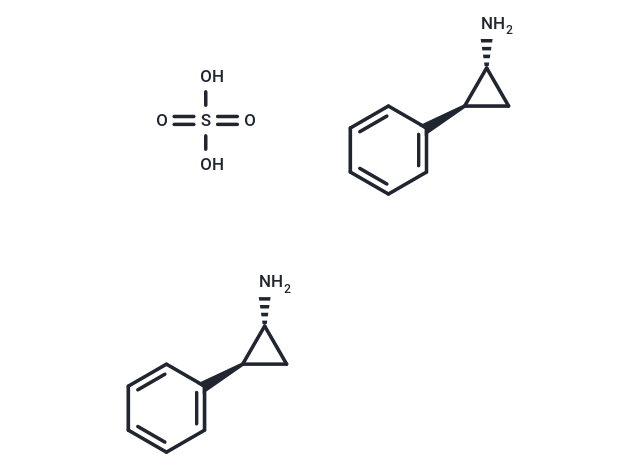Shopping Cart
Remove All Your shopping cart is currently empty
Your shopping cart is currently empty
Tranylcypromine hemisulfate (Tranylcypromine Sulfate) is an inhibitor of monoamine oxidase (MAO) and lysine-specific demethylase 1 (LSD1) with a rapid onset of activity.

| Pack Size | Price | USA Warehouse | Global Warehouse | Quantity |
|---|---|---|---|---|
| 50 mg | $35 | In Stock | In Stock | |
| 100 mg | $48 | In Stock | In Stock | |
| 500 mg | $107 | In Stock | In Stock | |
| 1 g | $156 | - | In Stock |
| Description | Tranylcypromine hemisulfate (Tranylcypromine Sulfate) is an inhibitor of monoamine oxidase (MAO) and lysine-specific demethylase 1 (LSD1) with a rapid onset of activity. |
| In vivo | Tranylcypromine-induced transcriptional and epigenetic regulation modulated RGC survival via the promotion of p38 MAPKγ activity. Therefore, pharmacologic treatments that suppress LSD1 activity may be a novel therapeutic strategy that can be used to treat neurodegenerative diseases[1]. |
| Animal Research | The authors evaluated whether tranylcypromine contributes to neuronal survival following stress-induced damage using primary cultured rat RGCs and in vivo N-methyl-D-aspartate (NMDA)-induced excitotoxicity.?Additionally, the molecules associated with tranylcypromine treatment were assessed by microarray and immunoblot analysis[1]. |
| Synonyms | Tranylcypromine Sulfate, Tranylcypromine (hemisulfate) |
| Molecular Weight | 182.23 |
| Formula | C9H11N 1/2H2SO4 |
| Cas No. | 13492-01-8 |
| Smiles | OS(O)(=O)=O.N[C@@H]1C[C@H]1c1ccccc1.N[C@@H]1C[C@H]1c1ccccc1 |
| Relative Density. | 1.065g/cm3 |
| Color | White |
| Appearance | Solid |
| Storage | store at low temperature | Powder: -20°C for 3 years | In solvent: -80°C for 1 year | Shipping with blue ice/Shipping at ambient temperature. | |||||||||||||||||||||||||||||||||||
| Solubility Information | H2O: 10 mg/mL (54.88 mM), Sonication is recommended. DMSO: 3.33 mg/mL (18.27 mM), Sonication is recommended. | |||||||||||||||||||||||||||||||||||
Solution Preparation Table | ||||||||||||||||||||||||||||||||||||
DMSO/H2O
H2O
| ||||||||||||||||||||||||||||||||||||
| Size | Quantity | Unit Price | Amount | Operation |
|---|

Copyright © 2015-2025 TargetMol Chemicals Inc. All Rights Reserved.